





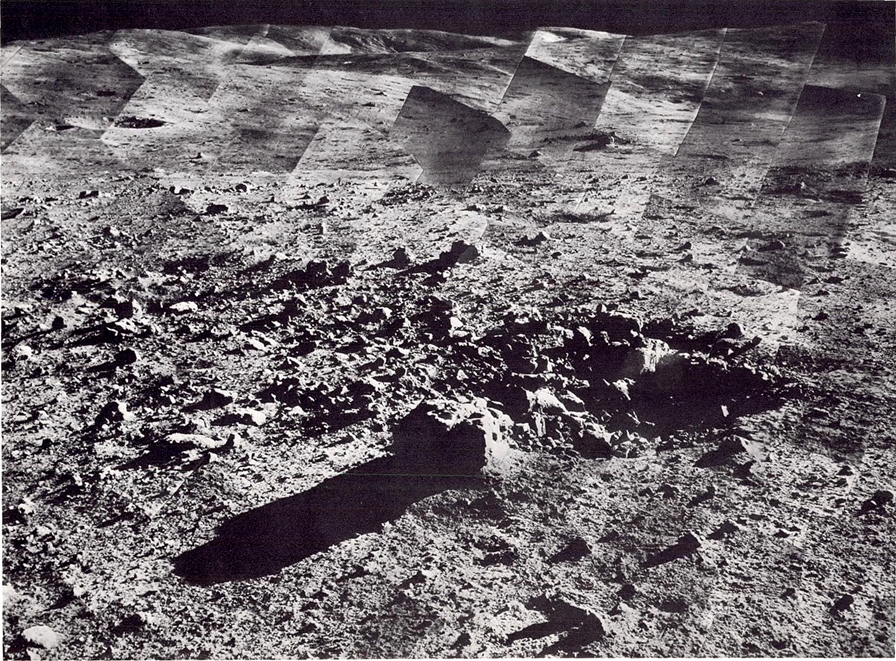













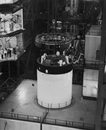








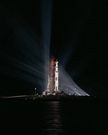
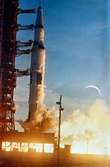
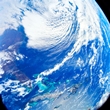
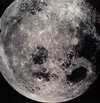






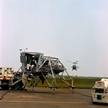



























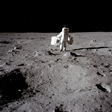


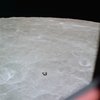


























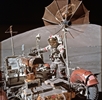

Here are following a series of pictures illutrating the Apollo program. Pictures are sorted according to the chronological order of missions
 | On July 24, 1962, Dr. John Houbolt explains his lunar orbit rendezvous concept for landing on the Moon. His approach called for a separate lander which saved weight from the "direct ascent" design in which the entire spacecraft landed on the lunar surface. click to a larger picture. picture courtesy NASA |
 | President Kennedy in 1962 attends a briefing given by Major Rocco Petrone during a tour of Blockhouse 34 at the Cape Canaveral Missile Test Annex. Also in attendance are Vice-President Lyndon Johnson and Secretary of Defense Robert McNamara. click to a larger picture. picture courtesy NASA |
 | The first image returned by Ranger 7. click to a larger picture. picture courtesy NASA |
 | Following on the steps of the Rangers, the Surveyors kept paving the way for the Apollo program, with the Surveyor 1 launching on May 30, 1966. In addition to transmitting more than 11,000 pictures, Surveyor sent information on the bearing strength of the lunar soil, the radar reflectivity or temperature. click to a larger picture. picture courtesy NASA/JPL |
 | A map of the Moon showing the locations of the five successful Surveyor soft landings. click to a larger picture. picture courtesy NASA |
 | A view of a lunar landscape by one of the Surveyor craft. click to a larger picture. picture courtesy NASA |
 | A composite of images taken by Surveyor 7 of its landing site near the rim of the crater Tycho. click to a larger picture. picture courtesy NASA |
 | A view of the relative size of the Saturn V rocket compared other US manned space flight rockets (left to right): Mercury-Redstone, Mercury-Atlas, Gemini-Titan, Apollo-Saturn 1B, and Apollo-Saturn V. click to a larger picture. picture courtesy NASA |
 | The Saturn I SA-4 flight launching by late March 1963 from NASAís Kennedy Space Center, a uncrewed test flight of the Saturn I booster. One-hundred seconds into flight, a pre-set timer disabled engine number 5 to test the 'engine-out' capability of the booster. Fuel was successfully rerouted to the other seven engines and the flight continued. click to a larger picture. picture courtesy NASA |
 | The AS-201, a Saturn 1B flight by February 1966 was part of flights by NASA's Marshall Space Flight Center (MSFC) to test the Saturn 1B launch vehicle and the Apollo Command and Service Modules. click to a larger picture. picture courtesy NASA |
 | The Apollo main parachute packs as seen underneath the forward heat shield. The Apollo ELS was Apollo parachutes program. click to a larger picture. picture courtesy NASA |
 | A Saturn 1B launching for a test flight with S-IVB second stage from the Complex 37-B at the Kennedy Space Center by Jul. 5, 1966. click to a larger picture. picture courtesy NASA |
 | Glynn Lunney (in white shirt at left) monitors the launch of Apollo 4 from the Mission Operations Control Room. Lunney like Kranz, a other famed flight director of the Apollo program, had distinguished himself as a flight director in challenging Gemini and early uncrewed Apollo missions. click to a larger picture. picture courtesy NASA |
 | A rare photo in September 1966 is showcasing two U.S. human space flight programs. A early stage of the Apollo program Saturn V launcher is seen behind the Gemini XI launching from Pad 19 at the Cape Canaveral Air Force Station (CCAFS), Florida. click to a larger picture. picture courtesy NASA |
 | The fifth, SA-5 Saturn I launch vehicle launched from NASA's Kennedy Space Center, a part of test-flights for varied elements of the Saturn V launch rocket. click to a larger picture. picture courtesy NASA |
 | The 363-foot tall Saturn V rocket getting out of the Vehicle Assembly Building, at the John F. Kennedy Space Center to its way to the Launch Complex 39A. The Saturn V was instrumental in successfully landing men on Moon. click to a larger picture. picture courtesy NASA |
 | The first flight test of the Saturn V vehicle, with the uncrewed Apollo 4 mission, stands ready for liftoff. click to a larger picture. picture courtesy NASA |
 | A lunar map showing the five candidate landing sites chosen by the Apollo Site Selection Board in February 1968 (left) and a close-up of the landing sites within the Apollo Zone of Interest (right). click to a larger picture. pictures courtesy NASA |
 | President Lyndon B. Johnson making a surprise visit to the Manned Spacecraft Center (MSC) on March 1st, 1968 as recalling that 'the one legislative accomplishment that I suppose I am proudest of is the bill that I wrote and introduced that made possible NASA...'. click to a larger picture. picture courtesy NASA |
 | The Apollo 6 Command Module being mated with its Service Module. click to a larger picture. picture courtesy NASA |
 | The Instrument Unit seen here lowered into place atop the third stage of the Saturn V launch vehicle in the Vehicle Assembly Building at Kennedy served as the 'nerve center' for the Saturn V, providing guidance and control, command and sequence of vehicle functions, telemetry and environmental control. click to a larger picture. picture courtesy NASA |
 | The Apollo 6 launch vehicle as it leaves Kennedyís Vehicle Assembly Building on the transporter heading to launch pad 39-A. click to a larger picture. picture courtesy NASA |
 | A display of the accepted ALSEP science experiments system for the Apollo missions at the Bendix Corp. click to a larger picture. picture courtesy NASA |
 | The Apollo spacecraft CSM-105 installed in the Vibration and Acoustic Test Facility (VATF) in Building 49 of the Manned Spacecraft Center (MSC), in the Kennedy Space Center, in view of the Apollo 7 mission, the first manned mission of the Apollo program. click to a larger picture. picture courtesy NASA |
 | The Apollo 7 CSM/Lunar Adaptator being lifted onto Saturn IB at Pad 34. click to a larger picture. picture courtesy NASA |
 | The Apollo 7 mission lifts off from Cape Kennedy (now Cape Canaveral) Air Force Station's Launch Complex 34 on Oct. 11, 1968. click to a larger picture. picture courtesy NASA |
 | The Apollo 7 crew was (from left) Command Module Pilot Donn Eisele, Commander Walter Schirra and Lunar Module Pilot Walter Cunningham. click to a larger picture. picture courtesy NASA |
 | Following launch, the Apollo 7 crew photographed the expended Saturn launch vehicle's second stage, called the S-IVB. NASA's Kennedy Space Center and Cape Kennedy (now Cape Canaveral) Air Force Station are visible on the lower left. The round, white disc inside the open panels of the S-IVB is a simulated docking target similar to that used for docking with a lunar module. click to a larger picture. picture courtesy NASA |
 | During stacking operations of the Apollo 8 mission in the VAB, the Saturn V launcherís third stage is lowered onto the second stage. click to a larger picture. picture courtesy NASA |
 | Searchlights penetrating the darkness surrounding Apollo 8 on Pad 39-A at Kennedy Space Center. This mission was the first manned flight using the Saturn V. click to a larger picture. picture courtesy NASA/MSFC |
 | The launch of the Apollo 8 space vehicle from the Kennedy Space Center at 7:51 a.m. (EST), Dec. 21, 1968. click to a larger picture. picture courtesy NASA |
 | A photograph of Earth taken from the Apollo 8 spacecraft while it was leaving Earth orbit. Most of the southeastern United States and the Caribbean Sea area, the U.S. coastline can be seen. The Bahamas and the islands of Cuba, in the Caribbean are visible in the lower left. click to a larger picture. picture courtesy NASA |
 | A photo taken from Apollo 8 during the mission's first approach to the Moon. click to a larger picture. picture courtesy NASA |
 | A oblique photograph taken by the Apollo 8 mission in orbit around the Moon, from 60 miles of altitudes, looking northwest into the Sea of Tranquility, the site where Apollo 11 was to land seven months. click to a larger picture. picture courtesy NASA |
 | By 11 degrees south latitude and between 118 and 114 east longitude over the Moon, with a westward view, the crew of Apollo 8, the first mission to round our natural satellite, captured that iconic view of the Earth which has been renamed 'Earthrise' and reproduced countless times, including a U.S. postage stamp in 1969. A first black-and-white snapshot had been taken about one minute before. click to a larger picture. picture courtesy NASA |
 | The Apollo 9 mission is launching from NASAís Kennedy Space Center, the second crewed mission of the Apollo program to launch on a Saturn V rocket. click to a larger picture. picture courtesy NASA |
 | The Apollo 9 mission which tested out the orbital rendezvous and docking procedures as part of the preparatory flights to the first landing on the Moon. click to a larger picture. picture courtesy NASA |
 | By March 1969, a successful simulation of recovery and quarantine operations with the Mobile Quarantine Facility was completed aboard the USS Guadalcanal in conjunction with the recovery of the Apollo 9 crew, operated like a test for the coming Apollo 11. click to a larger picture. picture courtesy NASA |
 | A lunar mission Command and Service Module (CSM), which was comprising the capsule where the crewmembers staid during most of the mission, and a service module behind. The CSM kept onto the lunar orbit while the LM was landing on the surface of the Moon. click to a larger picture. picture courtesy NASA |
 | Neil Armstrong in the Lunar Landing Training Vehicle-2 at Ellington Air Force Base in 1969, as the device allowed astronauts to train to control the LEM to the lunar surface. click to a larger picture. picture courtesy NASA |
 | A other view of a lunar mission Command, the capsule where the crewmembers staid during most of a Apollo mission. click to a larger picture. picture courtesy NASA |
 | In the Manned Spacecraft Operations (now the Neil Armstrong Operations and Checkout) Building at NASA's Kennedy Space Center in Florida, the lunar module for Apollo 10 is being moved for mating with the spacecraft lunar module adapter. Apollo 10 orbited the Moon in May 1969 and served as a 'rehearsal' for the first lunar landing. click to a larger picture. picture courtesy NASA |
 | The first stage of the Apollo 10 Saturn V vehicle is hoisted in preparation for erection on a mobile launcher in High Bay 2 of the Vehicle Assembly Building at the Kennedy Space Center. Apollo 10 was the first crewed Apollo mission to reach the Moon's orbit. click to a larger picture. picture courtesy NASA |
 | A lunar crater as seen from orbit during the Apollo 10 mission. click to a larger picture. picture courtesy NASA |
 | A view of the lunar surface with a rille (Apollo 10 mission). click to a larger picture. picture courtesy NASA |
 | The Apollo 10 launch stack as seen during launch pad rollout. click to a larger picture. picture courtesy NASA |
 | The Apollo 10 (Spacecraft 106/Lunar Module 4/Saturn 505) Saturn V launcher flying away from Pad B, Launch Complex 39, Kennedy Space Center on May 18, 1969. click to a larger picture. picture courtesy NASA |
 | Overall view of the Mission Operations Control Room in the Mission Control Center, Building 30, on the first day of the Apollo 10 lunar orbit mission by May 1969 when the CSM was making the docking approach to the S-IVB for the LEM extraction. A color television transmission was being received from Apollo 10. click to a larger picture. picture courtesy NASA |
 | The Apollo 10 LM during rendezvous operations over the Moon. click to a larger picture. picture courtesy NASA |
 | Apollo 10 astronauts being helped out of the CM by Navy recovery swimmers while a helicopter hovers ready to hoist them aboard. click to a larger picture. picture courtesy NASA |
 | Here, Saturn V first stage is prepared for final assembly in the high bay area of the Vehicle Assembly Building at NASAís Kennedy Space Center. click to a larger picture. picture courtesy NASA |
 | The second, S-II stage for the Saturn V launcher getting stacked in the Cape Canaveral's Vehicle Assembly Building (VAB) in preparation for the Apollo 11 launch. click to a larger picture. picture courtesy NASA |
 | The Apollo 11 mission patch, which became one of the most recognizable patches in spaceflight history. click to a larger picture. picture courtesy NASA |
 | Workers lowering the CSM onto the LM/SLA in preparation for the Apollo 11 launch. click to a larger picture. picture courtesy NASA |
 | The Apollo 11 rocket moving from the Kennedy Space Center Vehicle Assembly Building (VAB) to Launch Pad 39A, on May 20, 1969. click to a larger picture. picture courtesy NASA |
 | Workers caring about the quarantaine MQF for the Apollo 11 mission. click to a larger picture. picture courtesy NASA |
 | The Lunar Flag Assembly prior to assembly and installation on the Apollo 11's LM Eagle. click to a larger picture. picture courtesy NASA |
 | Aldrin (left) and Armstrong during surface EVA training in preparation for the Apollo 11 launch. click to a larger picture. picture courtesy NASA |
 | Apollo 11's astronaut Collins in the Command Module (CM) simulator at KSC on June 19, 1969. click to a larger picture. picture courtesy NASA |
 | Neil A. Armstrong, Michael Collins and Buzz Aldrin, the crewmembers of the Apollo 11 capsule, participating into a countdown demonstration test. click to a larger picture. picture courtesy NASA |
 | The most iconic picture of the Apollo program, astronaut Buzz Aldrin on the Moon, during the Apollo 11 mission, the one who first landed on the Moon, on July 20th, 1969. click to a larger picture. picture courtesy NASA |
 | The Apollo 11 lunar LM, christened Eagle, in a landing configuration as getting distant from the Command and Service Module Columbia for the Moon landing. The long rod-like protrusions under the landing pods are lunar surface sensing probes sending a signal of landing upon contact with the lunar surface to the crew to shut down the descent engine. click to a larger picture. picture courtesy NASA |
 | A view from the LM during approach to landing site during the Apollo 11 mission is showing that tormented lunar landscape and also well illustrating how the lunar horizon looks closer than Earth's due to a smaller circumference of our Moon. click to a larger picture. picture courtesy NASA |
 | A view of the lunar surface as Armstrong and Aldrin saw it shortly after landing, taken through Aldrinís right side window. click to a larger picture. picture courtesy NASA |
 | Another iconic picture, the one of Buzz Aldrin's footprint on the lunar soil, as taken during the Apollo 11 mission, the first to land on Moon in July 1969. click to a larger picture. picture courtesy NASA |
 | A photographic illustration comparing the size of Apollo 11 Landing Site 2 with that of the metropolitan New York City area. The white overlay is printed over a lunar surface photograph taken from Apollo 10 during its lunar orbit mission. click to a larger picture. picture courtesy NASA |
 | The plaque lying on one of Apollo 11 Eagle LM's legs, reading 'Here men from the planet Earth first set foot upon the moon. July 1969 A.D. We came in peace for all mankind',' and a silicon disc bearing messages from world leaders. click to a larger picture. picture courtesy NASA |
 | Apollo 11 Lunar Module Pilot Buzz Aldrin is seen photographed by Neil Armstrong, as he carried the Passive Seismic Experiments Package (left) and the Laser Ranging Retroreflector (right) to the deployment area. These two experiments made up the Early Apollo Scientific Experiment Package at Tranquility Base in Moon's Mare Tranquillitatis, or the Sea of Tranquility. click to a larger picture. picture courtesy NASA |
 | Buzz Aldrin, one of both crew which took part into the first lunar landing, is seen besides the seismic equipment which was left on the lunar surface as a part of the Apollo 11 landing site, generally, is well seen. click to a larger picture. picture courtesy NASA |
 | Photograph of the Lunar Module at Tranquility Base taken by Neil Armstrong during the Apollo 11 mission. Darkened tracks lead leftward to the deployment area of the Early Apollo Surface Experiments Package (EASEP) and rightward to the TV camera. This is the furthest distance from the lunar module traveled by either astronaut while on the Moon. click to a larger picture. picture courtesy NASA |
 | One of a sequence, of images taken by Collins in the Columbia command module, showing Eagleís approach for docking after its ascent from the Moon's surface. click to a larger picture. picture courtesy NASA |
 | The image of the Earth taken by Apollo 11 astronauts during the last few hours of their approach back. click to a larger picture. picture courtesy NASA |
 | . click to a larger pictureRecovery operations for the Columbia capsule after splashdown. picture courtesy NASA |
 | The Apollo 11 astronauts walk from the recovery helicopter to the MQF in the USS Hornetís hangar bay as a portion of the backup MQF is visible behind the prime. click to a larger picture. picture courtesy NASA |
 | A closeup of U.S President Nixon and the three Apollo 11 astronauts in quarantine the MQF. click to a larger picture. picture courtesy NASA |
 | A exterior view of the Mobile Quarantine Facility MQF-001, a facility to prevent any contamination for exolife, including the transfer tunnel. click to a larger picture. picture courtesy NASA |
 | A part of Moon rocks returned to the Lunar Receiving Laboratory (LRL). click to a larger picture. picture courtesy NASA |
 | A overhead view of the three Apollo 11 astronauts tickertape parade in New York City. click to a larger picture. picture courtesy NASA |
 | An astronaut climbing down the ladder of the Lunar Module (LM) during the Apollo 12 mission which landed in the Ocean of Storms, on the Moon. click to a larger picture. picture courtesy NASA |
 | A 19-mile wide lunar crater as seen, from orbit, on the far side of the Moon, during the Apollo 11 mission. click to a larger picture. picture courtesy NASA |
 | A Apollo 12 mission astronaut probing the Surveyor 3 spacecraft in the Ocean of Storms, near their landing site as the mission brought Earth some parts of the Surveyor. click to a larger picture. picture courtesy NASA |
 | A mosaic of several pictures taken on the Moon's surface by astronauts of Apollo 12, and constituting a pano view of the mission's landing site. click to a larger picture. picture courtesy NASA |
 | A map of the Apollo 12 EVA1 and EVA2 traverses. click to a larger picture. picture courtesy NASA |
 | The Apollo 12 CM descending on its main parachutes moments before splashdown. click to a larger picture. picture courtesy NASA |
 | A view of a United States Navy Underwater Demolition Team swimmer assisting the Apollo 12 crew during recovery operations in the Pacific Ocean, near American Samoa. The three crew men were then picked up by helicopter and flown to the prime recovery ship, USS Hornet. click to a larger picture. picture courtesy NASA |
 | The ill-fated Apollo 13 crippled Service Module, as seen by the end of the mission after separation. The Apollo 13 mission was plagued by the explosion occurring in the Service Module as the crew used the LM like a lifeboat during a long journey to the Moon and back . click to a larger picture. picture courtesy NASA |
 | The Apollo 14 Command and Service Module as seen inside the Cape Canaveral Manned Spacecraft Operations Building. click to a larger picture. picture courtesy NASA |
 | The Apollo 14 launch set rolling out from the Vehicle Assembly Building (VAB), with the Saturn V stack and its mobile launch tower atop a huge crawler-transporter. click to a larger picture. picture courtesy NASA |
 | A additional view to the previous of the Apollo 14 launch set rolling out from the Vehicle Assembly Building (VAB). click to a larger picture. picture courtesy NASA |
 | The 363-foot tall Apollo 14 launch vehicle lifts off from Pad 39A at the Kennedy Space Center on Jan. 31, 1971, heading to Moon after the Apollo 13 failure! click to a larger picture. picture courtesy NASA |
 | A earthrise at Moon as seen during the Apollo 14 mission. Of note, the curvature and apparent closeness of the lunar horizon which are due to a smaller diameter of our satellite. click to a larger picture. picture courtesy NASA |
 | The Apollo 14 mission lunar LM, setting in Fra Mauro Highlands. click to a larger picture. picture courtesy NASA |
 | Astronaut Alan Shepard, a crewmember of the Apollo 14 mission as he stands beside the Modularized Equipment Transporter, a hand pulled cart which improved traverse capacities. click to a larger picture. picture courtesy NASA |
 | A view of the Lunar Rover Vehicle (LRV), a Moon rover which began endowing the Apollo missions since the Apollo 15; it was able to reach a 10 mph speed extending exploration range. click to a larger picture. picture courtesy NASA |
 | A mosaic of several pictures taken on the Moon's surface by astronauts of Apollo 15, and constituting a pano view of the mission's landing site. click to a larger picture. picture courtesy NASA |
 | That panorama combines two photographs taken by Apollo 15 lunar module pilot Jim Irwin, at the end of the second Apollo 15 moonwalk on August 1, 1971. It shows the Apollo Lunar Surface Experiments Package (ALSEP) site in the foreground as the Passive Seismic Experiment is seen beyond the left side. The Lunar Surface magnetometer lies in the background near the center as mission commander David R. Scott is leaning to his right and putting down the Apollo Lunar Surface drill used to take core samples and set up a heat flow experiment. The Solar Wind Spectrometer further is in the right foreground. click to a larger picture. picture courtesy NASA |
 | The Apollo 17 mission commander Eugene A. Cernan makes a short checkout of the Lunar Roving Vehicle before the first Apollo 17 extravehicular activity at the Taurus-Littrow landing site. click to a larger picture. picture courtesy NASA |
 | Apollo 17 commander Eugene Cernan approaching the parked Lunar Roving Vehicle. click to a larger picture. picture courtesy NASA |
| A mosaic of several pictures taken on the Moon's surface by astronauts of Apollo 17, and constituting a pano view of one of the mission's working area. click to a larger picture. picture courtesy NASA | |
 | Apollo 17 scientist-astronaut Harrison H. Schmitt as photographed by fellow-astronaute Eugene Cernan, is standing next to a huge, split lunar boulder during their third extravehicular activity (EVA) at the Taurus-Littrow landing site. click to a larger picture. picture courtesy NASA/Eugene Cernan |